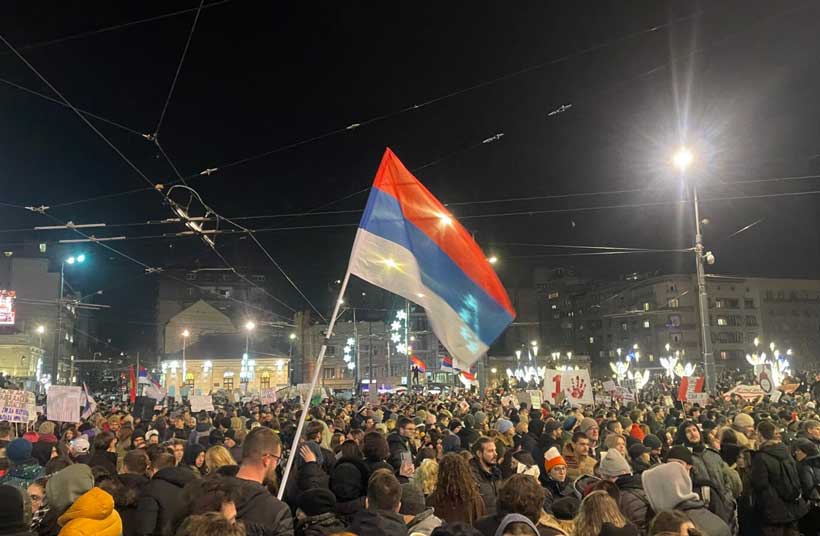Kragujevac, Serbia—15 February 1835 marked a fleeting moment of audacity. In this unassuming city, then Serbia’s capital, enlightenment-inspired reformers presented the Sretenje Constitution—a radical document inspired by Belgium’s liberal 1831 charter. It stipulated separation of powers in the parliamentary system, guaranteeing a high level of citizens’ rights from freedom of movement to equality regardless of religion and ethnicity.
It lasted only 55 days. Europe’s autocrats, though perpetually at odds, united to crush it. The Ottomans, Russians, and Austrians—architects of a conservative order—saw Serbia’s experiment as a threat.
15 February 2025, thousands will gather again in Kragujevac. This time, they demand accountable institutions and the rule of law in Serbia, haunted by corruption and authoritarian drift. Once again, they find themselves alone, if not directly opposed by the main geopolitical players of the day as in 1835, then pretty much ignored and snubbed.
The parallels are uncanny—and unsettling.
The ghosts of 1835
The Sretenje Constitution was groundbreaking in its era. Influenced by Enlightenment ideals, it was revolutionary even for Europe then, let alone for a backward Balkan principality still under nominal Ottoman suzerainty.
Thus, the Serbian constitution terrified empires. The Concert of Europe—a 19th-century coalition of monarchies—crushed such sparks of democracy. Stability, not justice, was their creed.
For all their differences, today’s global powers share a similar instinct. The EU, US, China, and Russia may spar over Ukraine or Taiwan, but in the Balkans, their interests align: keep the lid on. Why rock the boat?
Serbia’s 2025 protesters, like their 1835 forebears, will likely face a world more invested in order than ideals.
2025: When technology meets Athenian democracy
Yet 2025 is not 1835. Today’s activists use smartphones instead of quills, broadcasting dissent via social media and crowdfunding to fuel resistance. Their protests erupt into creative fireworks: music composed in solidarity, viral videos dissecting injustice, and performances that blur the line between art and activism, leaving legacies far beyond their protests.
In a striking echo of the past, Serbia’s student movements have resurrected the spirit of the direct democracy of ancient Athens. Across university faculties, every student has the right to propose ideas debated openly in collective assemblies—a modern-age agora.
They’ve even outpaced their Athenian forebears, rejecting hierarchical leadership entirely. Spokespeople rotate in a meticulously organised system: no individual may represent the movement twice, ensuring power remains dispersed.
Observers admire their clockwork precision—self-managed security, logistics, press teams, and supply chains operating seamlessly without central control. Future organisational and management theorists will study this remarkable combination of ancient egalitarianism, Enlightenment-inspired faith in human agency, and the power of algorithmic communication.
The paradox is palpable. As Serbia’s youth reinvent leaderless democracy, the world remains gripped by the fists of political dynasties and corporate titans. Yet the contrast grows starker still when geopolitics intrudes.
But Sparta is around
Technology may empower, but realpolitik suffocates. The European Union, a champion of democracy, ignores battles for democracy in its courtyard. It lectures Serbia on rule-of-law reforms while tacitly endorsing its hybrid regime where elections are stage-managed, the media shackled, and institutions reduced to nothing more than postal addresses. Stability trumps principle; Brussels’ gaze fixes on quelling Balkan turbulence, even if it means silencing the movements embodying European values.
Caught between empires old and new, Serbia’s youth navigate a minefield—their democratic experiment unfolding under the cold gaze of powers that prefer pawns to partners.
The choice of world powers is clear: support students’ demands for transparency and legality or make backroom deals with Serbia’s powerful ruler on securing border controls, energy deals, and access to the country’s natural resources. Their silence on the matter is a clear indication of their intentions.
A detour, not a dead-end
Serbia’s reformers were pioneers in 1835. In 2025, their heirs are at a similar point—fighting for basic human rights and dignity in a more connected and cynical world. While history tends to repeat itself, it doesn’t mean it can’t be rewritten. As the protesters gather in Kragujevac, the empires watch, and one can’t help but wonder how they will proceed this time around.
Note: This text is written in a personal capacity. It does not necessarily reflect the views of organisations with whom the author is professionally associated.
